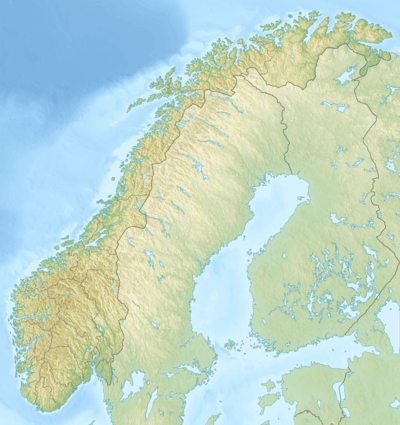Andøya Air Station
| Andøya Air Station | |||||||||||||||
|---|---|---|---|---|---|---|---|---|---|---|---|---|---|---|---|
|
A Norwegian P-3 Orion aircraft at Andøya, in 2011. | |||||||||||||||
| IATA: none – ICAO: none | |||||||||||||||
| Summary | |||||||||||||||
| Airport type | Military/Public | ||||||||||||||
| Operator | Royal Norwegian Air Force | ||||||||||||||
| Serves | Andenes | ||||||||||||||
| Elevation AMSL | 43 ft / 13 m | ||||||||||||||
| Coordinates | 69°17′33″N 16°08′39″E / 69.29250°N 16.14417°E | ||||||||||||||
| Map | |||||||||||||||
 Andøya Location in Norway | |||||||||||||||
| Runways | |||||||||||||||
| |||||||||||||||
Andøya Air Station (Norwegian: Andøya Flystasjon) is situated in the north of Norway, in the municipality of Andøy. At Andøya, the 333 Squadron is based with P-3C Orions. The squadron is Norway's only surveillance squadron and stands as the airborne defence of northern Norway. Andøya Air Station is designed to handle fighters and should it become necessary, fighter squadrons can be deployed to protect this region. Squadron 333 is the only Norwegian squadron still in operation after its initial deployment.
The civil airport Andøya Airport, Andenes and the civilian sounding rocket launch facility Andøya Rocket Range is also located on the island.
The six Orion aircraft primary function is surveillance, mostly in the north and for both military and civilian functions. The planes are also the only that can help ship wrecked far from land. The aircraft also have a lot of cooperation with the Norwegian Coast Guard.
The government has also proposed that new Maritime Patrol Aircraft shall be co-located with F-35 at Evenes Air Station. Evenes will also be strengthened with the establishment of dedicated base defence units and long-range air defences. Andøya air station is slated for clossure.
History
The first idea of building a military airport was launched at a NATO meeting in Lisbon in 1951. In March 1952 the Norwegian Minister of Defence, Nils Langhelle announced that the airport was going to be built. There were multiple suggested locations, and the decision fell on the village Haugnes. The entire village with 310 residents was expropriated to give enough area for the airport. The community at Andøy only had 2000 residents at the time, and a large growth was expected.
The first aircraft landing was on September 17, 1954, Douglas Dakota. The air station was operational from the fall 1957. The headquarters were located about 13 km away at Skarsteindalen, as part of NATOs spread tactic. In 1961 the first squadron, the 333, was moved to the air station, from Sola Air Station, with HU-16B Albatross aircraft.
After a bit civilian services were wanted, and April 2, 1964 the first schedules flight was flown by Scandinavian Airlines with a Metropolitan. In 1968 the second runway was finished. In the 1970s the airport became part of the new network of regional airports in Lofoten and Vesterålen with government subsidised operations with de Havilland DHC-6 Twin Otter aircraft seating 20 and operated by Widerøe.
The Albatrosses were replaced in 1969 with P-3B Orion aircraft. Though they lacked the ability to perform work for the Coast Guard and in 1989 they were sold to Spain and replaced with new P-3C aircraft. After the end of the Cold War in the 1990s the air station has been reduced.[1]
Accidents and incidents
- On February 1, 1982 a Lockheed SR-71, tail number 980, diverted to the airport. It stayed there four days before being flown out.[2]
- On July 31, 1988 four people died when a private Cessna 172 aircraft crashed west of the airport just after take off.[3]
See also
References
- ↑ Arheim, Tom; Hafsten, Bjørn; Thuve, Sverre (1994). Fra Spitfire til F-16: Luftforsvaret 50 år 1944–1994. Oslo: Sem & Stenersen. ISBN 82-7046-068-0.
- ↑ Trip Log of SR-71s That Diverted, Leland R. Haynes, http://www.wvi.com/~sr71webmaster/triplog66_86.htm .
- ↑ "Tidenes største, norske ulykker" [The biggest Norwegian accidents through time] (in Norwegian). Verdens Gang. 8 October 2011. Retrieved 1 December 2014.
External links
- Air Force page on Andøya (in Norwegian)
